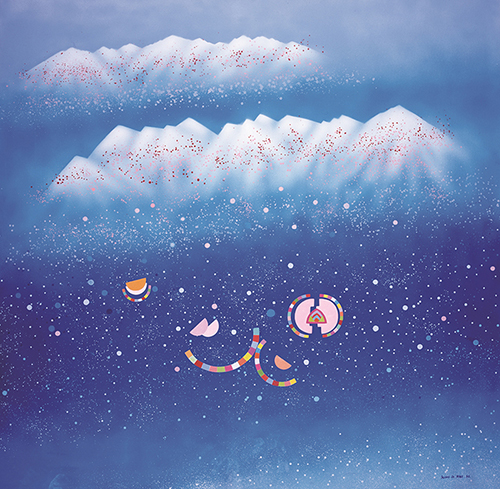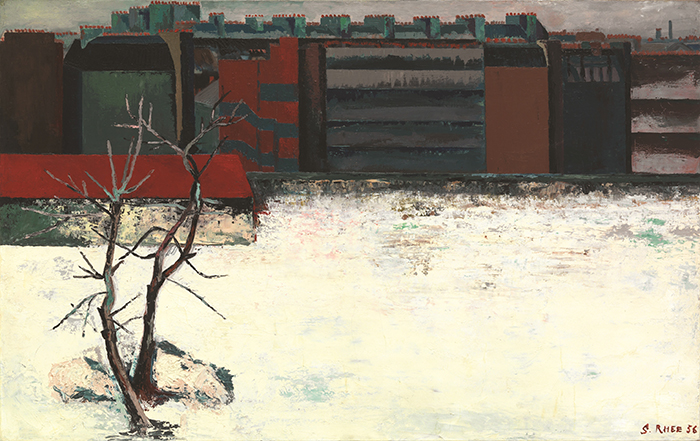-
 Korea.net's 24-hour YouTube channel
Korea.net's 24-hour YouTube channel- NEWS FOCUS
- ABOUT KOREA
- EVENTS
- RESOURCES
- GOVERNMENT
- ABOUT US

The exhibition 'Rhee Seundja: Road to the Antipode' opens in the Gwacheon Gallery 2 and in the Main Hall at the National Museum of Modern and Contemporary Art on March 22. The photo shows one of the Rhee's works that depicts the view from an airplane window as she travelled between Korea and France.
By Xu Aiying and Hahm Hee-eun
Photos = National Museum of Modern and Contemporary Art
The exhibition "Rhee Seundja: Road to the Antipode" opened in the Gwacheon Gallery 2 and in the Main Hall of the National Museum of Modern and Contemporary Art on March 22. Rhee Seundja (1928-2009) is a French-Korean artist who was influenced by Western painting. The exhibition shines a spotlight on Rhee's oeuvre, which has received more attention in France than in Korea until now.
Rhee was one of the most acknowledged Korean artists in France, and she was the first Korean artist to have a solo exhibition at famous French galleries like the Galerie Lara-Vincy and the Galerie Charpentier.
In the midst of the Korean War in 1951, Rhee Seundja boarded a plane for France. At the time, she was a 33-year-old woman who had just ended a 12-year marriage and had escaped to Busan in frustration and loneliness. She had no money and no fame, but with fortunate help from a diplomat she was able to fly to France that same year. After she arrived in France, painting was the only source of hope in her lonely life.
Initially, she entered a fashion design school, but at her teacher’s recommendation, she changed her path and learned the basics of painting at the Académie de la Grande Chaumière. She started to receive attention from French artists after Georges Boudaille, a famous art critic as well as curator, saw her work “The Snow on the Street of Vaugirard” in 1956. After 15 years living in France, she was able to come back to Korea and have her first solo exhibition in 1965.
For around 60 years, from the 1950s to the 2000s, Rhee Seundja has left more than 13,000 works of art, including oil paintings created in Paris, engravings created in her workroom in Tourrettes, a small village in southern France, and ceramics made in Korea.
Among her works, 127 representative works are on display at the National Museum of Modern and Contemporary Art to commemorate the 100th anniversary of her birth.
In the exhibition, Rhee's paintings and prints are on display chronologically, from "The Snow on the Street of Vaugirard" and "The Mother Who I Know," through to "Road to the Antipode."

Rhee Seundja’s debut work of art, ‘The Snow on the Street of Vaugirard,’ was painted in 1956. The painting received good reviews from Gerorges Boudaille, a famous critic and curator in France at the time.
Bartomeu Mari Ribas, director of the National Museum of Modern and Contemporary Art, said, “The 126 works of art that are on display in this exhibition completely portray the experimental oeuvre of Rhee Seundja. I hope that the exhibition can be an opportunity to broaden the scope of modern Korean art through her stereoscopic vision and international renown.”
The exhibition will continue until July 29.
xuaiy@korea.kr
Most popular
- First hearing-impaired K-pop act hopes for 'barrier-free world'
- Expats could account for 7% of population in 20 years: report
- 'Mad Max' director impressed by 'cinema-literate' Korean viewers
- Show in Italy to present 'thought-filled' Korean craftworks
- Romanian presidential couple visits national cemetery













